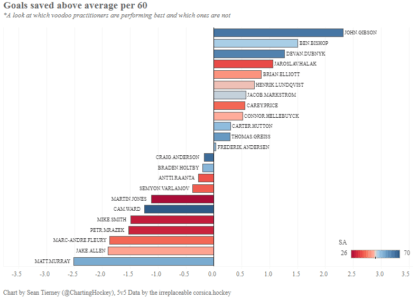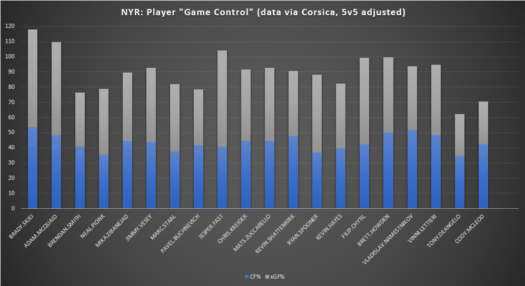
Admin Note: Please welcome aboard Rob Luker (@RLuker12) to the staff. Rob has done a bunch of guest spots here and there, and now he’s joined on relatively full time.
With the Rangers off until Thursday, there’s going to be plenty of analysis about the first three games of the 2018-19 season. This article will pile on top of all that, from the perspective of the numbers, and to do so I feel the need to make two prerequisite statements before we jump in:
- I only watched the Nashville game in full, while catching parts of the Buffalo/Carolina games (followed up by watching the condensed versions).
- Three games played in a year where the Rangers are not expected to make the playoffs means little, especially when the numbers most popularly analyzed do not begin to better predict team strength until the 20 or 30 games played
Now, with all that said, many of us were very much excited to see how the club would respond under David Quinn. Games one and two were encouraging, and if it had only been a two game week I think anyone leaning on the numbers would’ve been a little more positive than after game three. The first period of game three against Carolina was pretty even, but the Hurricanes started pouring on shots in the second and then firmly pulled away in the third. So how does the three game body of work look? With many teams only having 2 games played, we’re better off comparing the Rangers of this year to last for an idea of how the new roster is operating under Quinn.
The quick summary of this chart is that NYR is a very similar team to last year with one very bad goaltending performance. Going into the Carolina game, their CF% was around 47 with an improved CF/60 rate of around 49.5. The xGF% was hovering around 54.8 buoyed by an impressive game against Nashville, with the offense doing its usual thing and an xGA/60 below 2 (which would’ve been top 5 in the league last year). In the end, though, the Carolina game happened and we sit wondering if the first two games were a mirage or if the latter part of game three is more of the real New York Rangers for 2018-19.
Until more games are complete and the sample size becomes something real, opinions will be mixed as to what degree of bad NYR is. Personally, I wouldn’t mind seeing a 4-line forward team supported by a Defense that didn’t turn out to be absolutely horrid. This likely would not lead to a top three, or even potentially five, pick as many are hoping this rebuilding season turns out to be. The way a top pick like that would happen, however, is if the Carolina game became the norm rather than the exception as it is at this very early stage.
Before I highlight a few NYR skaters who are trending up and down, let’s just point out that Lundqvist had two good games that, if he keeps pace, would have him be a top ten goaltender in the league in terms of Goals Saved Above Average per 60 (via Sean Tierney)
To take a look at a few skaters, let’s start with a stacked bar chart with the players Corsi For % and Expected Goals % to see who stands out (sorted by 5v5 TOI, from left to right/most to least):
To note: Game Control isn’t an official stat: I’ve just nicknamed the adding of the two percentages together because in my mind if you’re succeeding in the shot and chance numbers, then you’re likely controlling the game while on the ice.
Trending Up
Brady Skjei: Skjei has had a great start to the season, playing top pair TOI competition for Ranger opponents while paired with Adam McQuaid. While I’m sure McQuaid being the stay-at-home type certainly helps Skjei mentally when taking risks, the relative numbers indicate thus far that he’s helping McQuaid’s results on the ice as well.
Jesper Fast: Fast was moved up in the lineup to play with Zibanejad and Kreider for game three, and while he’s struggling with the shot share battle right now, he’s going straight to the net when he enters the offensive zone. Only Jimmy Vesey, who has also had a nose for the net/chance thus far, has a higher individual Expected Goals For rate total thus far.
Brett Howden: The rookie has stepped into the fourth line center role seamlessly. One of three NYR skaters above 50% Corsi For (Skjei and Namestinkov are the others), he’s also creating chances with the second highest ixGF/60 rate on the team.
Trending Down
Brendan Smith: Having played the first two games with Shattenkirk and the last with DeAngelo, Smith did see plenty of ice time after his encouraging preseason. His underlying numbers thus far, however, haven’t been encouraging at all. I’d like to say Quinn is trying him in a shutdown role and it isn’t taking, however so far most of his TOI has been against middle or bottom six TOI forwards and bottom pair defense.
Cody McLeod: One game played, all negative numbers that put him towards the bottom of the forward roster. Please just play the kids that can make this a complete, four line forward team.
Neal Pionk/Marc Staal: If anyone knows what Pionk did to deserve his entry into the NHL to be hampered by a boat anchor by the name of Marc Staal, do let me know. Now he still firmly in the trending down category because of his results, with rates against that I would never advocate for, but until we see what he can do away from Staal I think many will continue to hold this opinion.
Trending … Even?
Kevin Shattenkirk: with a quiet opening week, many are saying Shattenkirk is a disappointment. While he did not stand out, he played normal minutes with Brendan Smith until being benched in game three after playing most of his limited minutes with Staal. My only curiosity is that his relative numbers bode well away from Smith in both shot share/corsi and expected goals, so this week could be interesting.
A footnote: Dave has been nice enough to offer me a somewhat regular spot here at Blue Seat Blogs, with a loose plan to write a numbers-based article bi-weekly along with any other topics that pop up. If anyone has any specific questions that you would like to see covered, even if it’s non-NYR related, please feel free to let me know!
Share:
More About:Analysis



